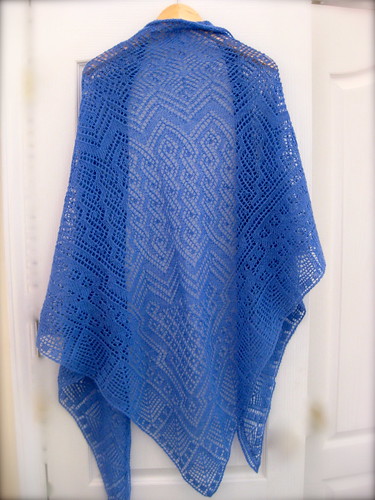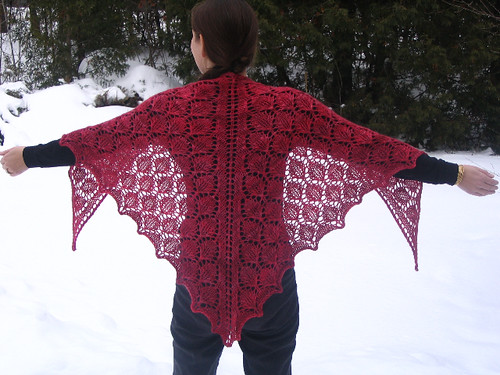I’ve always liked math. And when it comes to math, geometry is particularly fun. All these fancy shapes and angles and lines that do or don’t intersect. I’m not certain that everyone shares my passion (actually, I’m certain that lots of people don’t), but the amazing thing with math is that there is a nice, neat solution to…. well…. everything. This interest in math has definitely carried over into my knitting.

When I first decided to design a triangular lace shawl, I thought about how one might construct a triangle. The first and most obvious solution came to mind – start at the bottom point and make the rows longer as you go. And thus Mystic Waters was born.
The inverse construction is of course also possible – I could have started at the top edge, cast on lots and lots of stitches and made each row shorter until I reached the point where I couldn’t decrease any further. The main draw-back in my mind of that method is that I really don’t like casting on lots and lots of stitches and counting them, and recounting them to be sure I have the right number. Sometimes it is of course a necessary exercise, but it’s so much simpler to start with two stitches. Or four. Or five. Or something more manageable than fourhundredandtwentyseven.
 Once I had created Mystic Waters though, I noticed that there are a lot of triangular shawls that are made out of TWO triangles. So then it was time for another experiment, which resulted in the Sumac Leaf Shawl. This shawl is constructed from two triangles starting at the nape of the neck and growing outwards so that the longest edge of each triangle forms the bottom edge of the shawl. This construction is easily recognizable, because there is a well defined “spine” of the shawl. It’s quite common, and can be seen in shawls like Icarus, Ishbel and Swallowtail. The advantage of this type of construction over the bottom-up triangle used for Mystic Waters is that the shawl drapes quite nicely over your shoulders. The fabric stretches in a different direction, and pulls evenly towards the bottom edges of the shawl. And once again you start with relatively few stitches.
Once I had created Mystic Waters though, I noticed that there are a lot of triangular shawls that are made out of TWO triangles. So then it was time for another experiment, which resulted in the Sumac Leaf Shawl. This shawl is constructed from two triangles starting at the nape of the neck and growing outwards so that the longest edge of each triangle forms the bottom edge of the shawl. This construction is easily recognizable, because there is a well defined “spine” of the shawl. It’s quite common, and can be seen in shawls like Icarus, Ishbel and Swallowtail. The advantage of this type of construction over the bottom-up triangle used for Mystic Waters is that the shawl drapes quite nicely over your shoulders. The fabric stretches in a different direction, and pulls evenly towards the bottom edges of the shawl. And once again you start with relatively few stitches.
It is also possible to do the inverse construction of this type of shawl, by casting on even more stitches to cover the entire bottom V of the shawl and then work towards the neck. The Miralda Triangular shawl by Nancy Bush is an example of that construction. But again, the fact that I can’t face the idea of casting on fourhundredandtwentyseven-times-two stitches has kept me from designing a shawl using this inverse construction.
These are just a few ways to construct triangles. There are several others as well, but those are probably the most common when it comes to shawls.
Almost all of my patterns have been a result of me experimenting with shapes and constructions. I do enjoy playing with different combinations of shapes. They all have their advantages and disadvantages, which are fun to figure out while knitting. And the one thing that I can promise all the participants of the Seasons of Lace, is that each and every shawl for the next six months will be constructed differently. The very first shawl, Skuld, is a triangle shawl constructed in a manner not used for any of my previous shawls. I hope you enjoy it.

